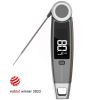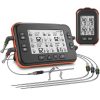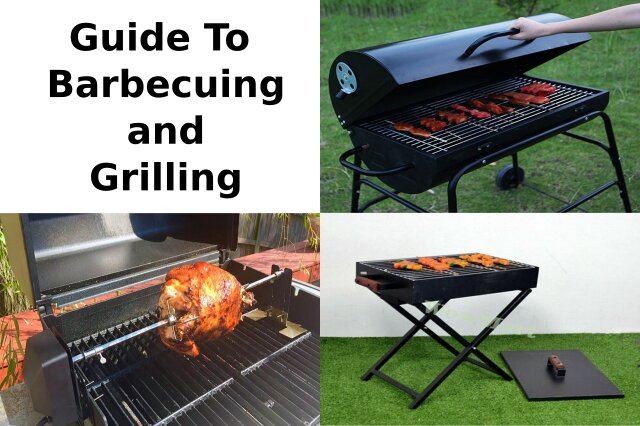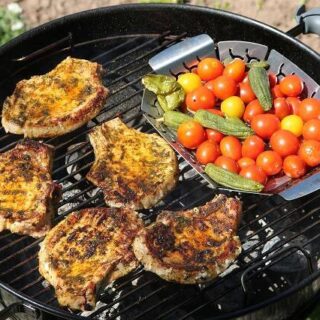Comprehensive Barbecue Guide:
Tips, Techniques & Recipes
Welcome to the ultimate barbecue guide! Whether you’re a seasoned pitmaster or a beginner griller, this comprehensive resource is packed with tips, techniques, and mouthwatering recipes to enhance your barbecue skills.
In this article, we’ll dive deep into the art of barbecue, exploring everything from choosing the right grill to mastering the perfect smoke ring.
Get ready to take your outdoor cooking game to the next level as we demystify the barbecue process and equip you with the knowledge you need to become a backyard BBQ hero.
From classic favourites like Classic Cheeseburgers, Smoky BBQ Ribs, Grilled Vegetable Skewers, Grilled Corn on the Cob and Grilled Chicken Skewers, we’ve got you covered with a wide range of recipes that will please both meat lovers and vegetarians alike.
Plus, we’ll share insider secrets and pro tips to help you achieve that coveted smoky flavour and tender, juicy results every time.
So, grab your apron, fire up the grill, and get ready to embark on a mouthwatering journey.
With this ultimate barbecue guide in your hands, you’ll be hosting legendary cookouts and creating unforgettable moments with friends and family in no time.
Let’s get grilling!
[lwptoc]
Barbecue techniques – direct heat vs. indirect heat.
One of the fundamental techniques in barbecue is understanding the difference between direct heat and indirect heat cooking.
By mastering both direct and indirect heat techniques, you’ll have the flexibility to cook a wide variety of dishes on your barbecue.
Whether you’re searing a steak or slow-smoking a rack of ribs, knowing when and how to use each method will elevate your barbecue game to new heights.
Each method has its own advantages and is suitable for different types of food.
- Direct heat cooking:
- Direct heat cooking involves placing the food directly over the flame or heat source.
This method is ideal for quick-cooking foods such as burgers, steaks, and vegetables.The high heat sears the surface, creating a flavourful crust while maintaining juicy interiors.
To cook with direct heat;
- Preheat your grill or barbecue hotplate to medium-high or high heat.
- Place the food directly over the heat source and cook for the recommended time, flipping as needed.
- Be sure to monitor the temperature to prevent burning or drying out the food.
This method is perfect for achieving those beautiful grill marks or searing on steaks, burgers, and vegetables.
- Indirect heat cooking:
- Indirect heat cooking, on the other hand, involves placing the food away from the direct heat source.
This method is perfect for slow-cooking large cuts of meat or delicate foods that require gentle heat.
It allows the meat to cook slowly and evenly, resulting in tender, succulent results.To cook with indirect heat;
- Preheat one side of your grill to medium or medium-high heat and leave the other side unlit.
- Place the food on the unlit side and close the lid.
This creates a convection effect, circulating the heat around the food for even cooking. - Use a meat thermometer to ensure the meat reaches the desired internal temperature.
Indirect heat grilling is ideal for larger cuts of meat like whole chickens or pork shoulders.
Both direct and indirect heat cooking have their place in barbecue. Experiment with different techniques to discover your preferred method for different types of food.
With practice, you’ll become a master of controlling heat and achieving perfectly cooked dishes.
Now that you understand the basics of direct and indirect heat grilling, let’s move on to the types of barbecues and equipment along with some essential tools and accessories you’ll need for a successful barbecue.
Types of barbecues and equipment.
When it comes to barbecuing, the first step is to choose the right equipment.
There are various types of barbecues available in the market, each with its own advantages and disadvantages.
The most common types include charcoal grills, gas grills, and pellet grills.
- Charcoal grills;
- Charcoal grills are the traditional choice for barbecue enthusiasts.
They provide that authentic smoky flavour and are great for searing steaks and burgers.However, they require more time and effort to set up and maintain the right temperature.
- Gas grills and Hotplates;
- Gas grills and hotplates, on the other hand, offer convenience and ease of use.
With just a turn of a knob, you can quickly achieve the desired temperature.They are perfect for beginners and those who prefer a hassle-free grilling experience.
However, gas grills may not provide the same smoky flavour as charcoal grills.
- Pellet grills;
- Pellet grills combine the convenience of gas grills with the flavour of charcoal grills.
They use wood pellets as fuel, which adds a distinct smoky taste to your food.These grills also offer temperature control, making it easier to achieve consistent results.
No matter which type of grill you choose, it’s important to invest in quality equipment.
Look for durable construction, good heat retention, and easy cleaning features.
Additionally, consider purchasing essential accessories such as grill brushes, tongs, meat thermometers, and grill mats to enhance your barbecue experience.
Essential barbecue tools and accessories.
To achieve barbecue greatness, you need the right tools and accessories.
Here are some essential items that every BBQ enthusiast should have in their arsenal:
- Smoker box:
- If you’re into smoking, a smoker box or wood chips will add that smoky flavour to your barbecue.
- Meat injector:
- For those who want to take their barbecue to the next level, a meat injector is a handy tool for injecting marinades or brines directly into the meat, enhancing its flavour and tenderness.
- Grill brush:
- A grill brush is essential for keeping your grill grates clean and free from debris.
Regularly brushing the grates before and after cooking will prevent food from sticking and ensure even heat distribution.
- Tongs:
- A good pair of tongs is a must-have for flipping and turning food on the grill.
Look for tongs with long handles to keep your hands away from the heat.
- Meat thermometer:
- To ensure your meat is cooked to perfection, invest in a reliable meat thermometer.
This will help you avoid undercooked or overcooked meat and ensure food safety.
Why You Should Use a ChefsTemp Thermometer When Cooking
A ChefsTemp thermometer is an essential tool for any cook or baker.
It allows you to monitor the internal temperature of your food more accurately, which helps you achieve consistent results and perfect textures.Additionally, it can be used to make sure that food has reached safe temperatures, ensuring that it's safe to eat.
Unlike other thermometers, the ChefsTemp reads quickly and accurately in both Celsius and Fahrenheit.- ChefsTemp Pocket Pro

- Description:Professional thermocouple probe sensor with 1 second reading time, this pocket size kitchen gadget is suitable for both professional chefs and home cooks. Pocket Pro is another amazing innovation from ChefsTemp. It is a 4-way rotating display thermometer,
- Price: $34.99
- ChefsTemp Finaltouch X10

- Description:Finaltouch X10 is the Winner of Red Dot Product Design in 2022. The Red Dot Design Award is one of the three most prestigious professional design competitions in the world. Winning the award proves its the Leader in Design and Technology. Chefs around the
- Price: $69.99
- ChefsTemp Quad Xpro

- Description:Quad XPro is designed to track temperatures over an extended period of time with moderate-heat cooking methods, such as smoking, oven-roasting, deep-frying, home brewing, and Sous Vide and to be used while grilling.
- Price: $109.99
- Grill spatula:
- A grill spatula is perfect for flipping burgers, steaks, and delicate foods like fish.
Look for a spatula with a wide, sturdy blade that can handle heavy meats.
- Grill gloves:
- Protect your hands from the heat with a pair of heat-resistant grill gloves.
These gloves will allow you to handle hot grill grates and utensils without getting burned.
- Grill baskets:
- Grill baskets are great for cooking smaller or delicate foods that might fall through the grates.
Use them for grilling vegetables, shrimp, or even diced meat for skewers or kebabs.
Having these essential tools and accessories will make your barbecue experience more enjoyable and efficient.
Now that you’re equipped with the right gear, let’s move on to the next step in the barbecue process, choosing the right meat for barbecuing.
Choosing the right meat for barbecuing.
The key to a successful barbecue lies in choosing the right meat. While almost any type of meat can be cooked on a grill, certain cuts and varieties are more suitable for barbecuing.
- Beef:
- When it comes to beef, cuts like ribeye, brisket, and short ribs are ideal for low-and-slow cooking.
These cuts have a good amount of marbling, which adds flavour and helps keep the meat moist during long cooking times.For burgers, choose ground beef with a higher fat content to ensure juiciness.
- Pork:
- Pork offers a wide range of options for barbecuing. Spare ribs, baby back ribs, and pork shoulder are popular choices.
The slow cooking process breaks down the collagen in the meat, resulting in tender, fall-off-the-bone goodness.Pork chops and tenderloin can also be grilled, but they require shorter cooking times to prevent drying out.
- Lamb:
- Lamb is a popular choice for barbecuing.
Lamb shoulder, ribs, forequarter chops and neck rosette are typically tender and succulent when slow cooked using indirect heat. Once again the slow cooking process breaks down the collagen in the meat.Cutlets, loin chops and chump chops are ideal for barbecuing and best suited to high direct heat cooking methods.
They require less cooking time and are perfect for the grill or hotplate. - Chicken:
- Chicken is another versatile meat for barbecuing. Whole chickens, chicken thighs, and drumsticks are great for low-and-slow cooking.
If you prefer boneless, skinless chicken breasts, consider marinating them beforehand to keep them moist and flavourful.
- Seafood:
- For seafood lovers, fish fillets, prawns, shrimp, and scallops can be grilled to perfection.
The delicate nature of seafood requires careful attention to prevent overcooking. Use a grill basket or skewers to keep smaller pieces from falling through the grates.
When selecting meat for barbecuing, choose cuts that are fresh and of high quality. Look for vibrant color, firm texture, and well-marbled pieces.
this all contributes to the flavour and juiciness of the final dish.
Don’t be afraid to ask your butcher for recommendations or tips on preparing and cooking specific cuts.
Now that you’ve got your meat sorted out, let’s move on to the next step in the barbecue process – marinating and seasoning your meat.
Marinating and seasoning your meat.
Marinating and seasoning your meat is an essential step in achieving delicious and flavourful results.
The process of marinating involves soaking your meat in a mixture of herbs, spices, and other ingredients to enhance its tenderness and flavour.
Seasoning, on the other hand, involves adding dry rubs or spices directly onto the meat before grilling.
Both techniques contribute to creating a mouthwatering barbecue experience.
Here are some tips for marinating and seasoning your meat:
- Choose the right marinade:
- When selecting a marinade, consider the flavours you want to infuse into your meat.
For a classic barbecue flavour, opt for a marinade that includes ingredients like garlic, onion, Worcestershire sauce, and brown sugar.
If you’re feeling adventurous, try experimenting with different flavours like teriyaki, citrus, or honey mustard.
- Give it time:
- For maximum flavour, marinate your meat for at least 30 minutes to overnight.
The longer the marination time, the more pronounced the flavours will be.However, be cautious not to marinate for too long, as the meat can become mushy or overly tender.
- Season generously:
- Before grilling, season your meat with a Dry Rub or spice blend.
This will add an extra layer of flavour and create a delicious crust on the outside of the meat.Experiment with different seasonings like paprika, cumin, chili powder, or herbs like rosemary and thyme.
- Let it rest:
- After seasoning your meat, allow it to rest at room temperature for 15-30 minutes before grilling.
This will allow the flavours to penetrate the meat and ensure even cooking.
- Baste with marinade:
- While grilling, baste your meat with the marinade every few minutes to enhance the flavours and keep the meat moist.
Be sure to discard any remaining marinade that has come into contact with raw meat to avoid cross-contamination.
By following these marinating and seasoning tips, you’ll elevate the flavours of your barbecue and create a memorable dining experience for your guests.
Now that you have the basics covered, let’s explore smoking techniques for adding that extra burst of flavour to your barbecue.
Smoking techniques for added flavour.
Smoking is a technique that adds a distinct, smoky flavour to your barbecue.
It involves cooking food at a low temperature over indirect heat, using wood chips or chunks to generate smoke.
The type of wood you choose will influence the flavour profile of your barbecue.
Here are some popular wood options and their corresponding flavours:
- Hickory:
- Hickory wood gives a strong, smoky flavour that pairs well with beef, pork, and poultry.
It’s a popular choice for traditional barbecue dishes like ribs and brisket.
- Mesquite:
- Mesquite wood imparts a robust, earthy flavour that complements beef and game meats.
It’s commonly used in Texas-style barbecue.
- Apple:
- Apple wood provides a slightly sweet and fruity flavour that works well with poultry, pork, and vegetables.
It’s a versatile wood that adds a subtle touch to your barbecue.
- Cherry:
- Cherry wood offers a mild, fruity flavour that pairs well with poultry, pork, and fish.
It adds a touch of sweetness and a beautiful reddish hue to your barbecue.
- Maple:
- Maple wood provides a sweet and delicate flavour that pairs well with poultry, ham, and vegetables.
It’s a great choice for adding a subtle smoky flavour to lighter dishes.
- Manuka:
- Manuka is a native New Zealand tree with a dense, hardwood that produces a heavy smoke with a slightly sweet flavour.
It is a good all-rounder for smoking meat, seafood, poultry, and vegetables.
- Pohutukawa:
- Pohutukawa is another native New Zealand tree with a hard, durable wood that produces a strong smoke with a nutty flavour.
It is well-suited for smoking meats, such as beef, pork, and lamb.
- Fruitwoods:
- Fruitwoods, such as apple, cherry, and peach, are also popular for smoking in Australia and New Zealand.
They produce a milder smoke with a sweeter flavour that is well-suited for smoking poultry, fish, and vegetables.
- Oak:
- Oak is another popular wood chip for smoking in many countries.
It has a mild, smoky flavour that is versatile enough for smoking a variety of meats, including fish, poultry, beef, and pork. - Pecan:
- Pecan is a good wood chip for smoking meats that have a delicate flavour, such as chicken and fish.
It has a mild, nutty flavor that adds sweetness and complexity to smoked foods.
Here are some additional tips for using wood chips when barbecue smoking:
- To achieve the best results with smoking, soak your wood chips or chunks in water for about 30 minutes before using them.
This will prevent them from burning too quickly and create a steady release of smoke. - Place the soaked wood chips or chunks directly on the coals or in a smoker box if using a gas grill.
- Close the lid and allow the smoke to infuse into the meat for the desired amount of time.
- Remember to monitor the temperature and adjust the vent settings to maintain a consistent smoke level. Smoking can take several hours, depending on the type and size of the meat.
- Patience is key when it comes to smoking, as slow and low cooking results in tender, flavourful barbecue.
Now that you’re familiar with smoking techniques, let’s move on to some tips for controlling temperature and smoke.
Tips for controlling temperature and smoke on the grill.
Controlling the temperature and smoke on your grill is essential for achieving barbecue perfection.
Here are some tips to help you become a master of heat and smoke:
- Heat Zones:
- Create different heat zones on your grill by arranging the coals or burners to have a hot zone and a cooler zone.
This allows for more control over the cooking process and prevents flare-ups.
- Vent Control:
- Adjust the vents on your grill to control the airflow and temperature.
Opening the vents allows for more oxygen and a hotter fire, while closing them reduces the airflow and lowers the heat.
- Fuel Management:
- Whether you’re using charcoal or gas, it’s important to manage your fuel source. For long, slow cooks, add more fuel as needed to maintain a consistent temperature.
- Smoke Control:
- If you’re using wood chips or chunks for smoke flavour, soak them in water before adding them to the grill.
This will prevent them from burning too quickly and producing acrid smoke.
Remember, practice makes perfect when it comes to controlling temperature and smoke.
Don’t be afraid to experiment and adjust your techniques to achieve the desired results.
Now that you’re familiar with controlling temperature and smoke, let’s move on to some common barbecue mistakes to avoid.
Common barbecue mistakes to avoid.
Even the most seasoned pitmasters make mistakes from time to time.
Here are some common barbecue pitfalls to avoid:
- Lack of Patience:
- Barbecue is a slow and steady process.
Rushing the cooking time or constantly opening the grill lid can result in uneven cooking and dry meat.
- Over-seasoning:
- While seasoning is important, it’s easy to go overboard. Start with a light hand and adjust as needed, tasting along the way.
- Sauce Too Early:
- If you’re using barbecue sauce, be mindful of when you apply it.
Adding it too early can result in burning or charring.
- Not Resting the Meat:
- Resting the meat allows the juices to redistribute, resulting in a more flavourful and tender end product.
Don’t skip this vital step.
By avoiding these common mistakes, you’ll be well on your way to barbecue greatness.
Now that you’ve covered common barbecuing mistakes, let’s move on to some important barbecue safety tips.
Barbecue safety tips.
While barbecuing is a fun and enjoyable activity, it’s important to prioritize safety to prevent accidents and ensure a smooth grilling experience.
Here are some essential barbecue safety tips to keep in mind:
- Position your grill correctly:
- Place your grill in a well-ventilated area away from any flammable materials, such as trees, fences, or buildings.
Ensure that it’s on a stable surface to prevent tipping.
- Keep a fire extinguisher nearby:
- In case of an emergency, have a fire extinguisher within reach.
Make sure you know how to use it properly and that it’s in good working condition.
- Use long-handled tools:
- To avoid burns, use long-handled tools like tongs and spatulas to handle food on the grill.
This will keep your hands away from the heat source.
- Never leave the grill unattended:
- It’s important to always keep an eye on your grill while it’s in use.
This will help prevent flare-ups and ensure that everything is cooking properly.
- Use a meat thermometer:
- To ensure that your meat is cooked to a safe internal temperature, use a meat thermometer.
This will help prevent foodborne illnesses and ensure that your barbecue is both delicious and safe to eat.
- Practice proper food handling:
- Wash your hands and utensils thoroughly before and after handling raw meat.
Keep raw and cooked foods separate to avoid cross-contamination.
Use clean platters and utensils for cooked food.
By following these safety tips, you can enjoy your barbecue experience with peace of mind.
Now that we’ve covered the essentials, let’s move on to the most exciting part – mouthwatering barbecue recipes that will please both meat lovers and vegetarians alike.
5 Mouthwatering barbecue recipes
Here's our list of what we're making -
Classic Cheeseburgers, Smoky BBQ Ribs, Grilled Vegetable Skewers, Grilled Corn on the Cob, Grilled Chicken Skewers
Ingredients
Classic Cheeseburger Ingredients:
- 450 grams 1 pound minced (ground) beef (80% lean)
- Salt and pepper to taste
- 4 hamburger buns
- Cheese slices cheddar, tasty, American, or your favourite cheese
- Lettuce tomato, onion, and condiments of your choice
Smoky BBQ Ribs Ingredients:
- 2 racks of baby back ribs
- ½ cup brown sugar
- 2 tablespoons paprika
- 1 tablespoon garlic powder
- 1 tablespoon onion powder
- 1 tablespoon chili powder
- 1 tablespoon salt
- 1 teaspoon black pepper
- BBQ sauce of your choice
Grilled Vegetable Skewers Ingredients:
- Assorted vegetables capsicum/bell peppers, zucchini, cherry tomatoes, mushrooms, red onions
- Olive oil
- Salt and pepper to taste
- Fresh herbs such as rosemary or thyme
Grilled Corn on the Cob Ingredients:
- 4 ears of corn
- 1 tablespoon butter softened
- ¼ teaspoon salt
- ¼ teaspoon black pepper
Grilled Chicken Skewers Ingredients:
- 450 grams 1 pound boneless, skinless chicken breasts, Dice into 2.5cm (1-inch) cubes
- ¼ cup olive oil
- 2 tablespoons lemon juice
- 1 teaspoon salt
- ½ teaspoon black pepper
- ¼ teaspoon garlic powder
- ¼ teaspoon onion powder
- ¼ teaspoon paprika
Instructions
Classic Cheeseburger Instructions:
- Preheat your grill to medium-high heat.
- Shape the ground beef into four patties, about 2cm (¾ inch) thick.
- Season the patties with salt and pepper on both sides.
- Place the patties on the grill and cook for about 4-5 minutes per side for medium doneness.
- During the last minute of cooking, add cheese slices on top of each patty to melt.
- Toast the hamburger buns on the grill for a few seconds until lightly browned.
- Assemble the burgers with lettuce, tomato, onion, condiments, and your favourite sauce.
- Serve hot and enjoy!
Smoky BBQ Ribs Instructions:
- Preheat your grill to 110°C (225°F) for indirect heat cooking.
- Remove the membrane from the back of the ribs by sliding a butter knife under the membrane and lifting it off.
- In a bowl, combine brown sugar, paprika, garlic powder, onion powder, chili powder, salt, and black pepper to make the dry rub.
- Rub the dry rub all over the ribs, ensuring even coverage.
- Place the ribs on the grill, bone-side down, away from the flame.
- Close the lid and let the ribs cook low and slow for 3-4 hours or until tender.
- During the last 30 minutes of cooking, baste the ribs with your favourite BBQ sauce.
- Once cooked, remove the ribs from the grill and let them rest for a few minutes before slicing and serving.
Grilled Vegetable Skewers Instructions:
- Preheat your grill to medium-high heat.
- Cut the vegetables into bite-sized pieces.
- Thread the vegetables onto skewers, alternating different types for an attractive presentation.
- Drizzle the vegetable skewers with olive oil and season with salt, pepper, and fresh herbs.
- Place the skewers on the grill and cook for about 8-10 minutes, turning occasionally, until the vegetables are tender and lightly charred.
- Remove from the grill and serve hot as a delicious side dish or as a vegetarian main.
Grilled Corn on the Cob Instructions:
- Preheat the grill to medium heat.
- Peel back the husks of the corn and remove the silks.
- Brush the corn with butter and season with salt and pepper.
- Place the corn on the grill and cook for 5-7 minutes per side, or until charred and tender.
- Serve with your favourite dipping sauce. This drawn butter sauce goes well with your hot corn.
Grilled Chicken Skewers Instructions:
- Preheat the grill to medium heat.
- In a medium bowl, combine the chicken, olive oil, lemon juice, salt, pepper, garlic powder, onion powder, and paprika.
Mix well. - Thread the chicken onto skewers.
- Place the skewers on the grill and cook for 5-7 minutes per side, or until cooked through.
- Serve with your favourite dipping sauce such as this tangy cocktail sauce.
Notes
Conclusion and final tips for barbecue success.
Congratulations, you've reached the end of our comprehensive barbecue guide! Armed with expert tips and tricks, you're now equipped to take your grill game to new heights. Remember these final tips for barbecue success:- Practice:
Barbecue is an art that requires practice and patience. Keep experimenting and refining your techniques to become a true barbecue master. - Safety First:
Always prioritise food safety by properly handling, storing, and cooking your meat. Use a meat thermometer to ensure it reaches the appropriate internal temperature. - Have Fun:
Barbecuing is not just about the end result; it's also about enjoying the process.
Invite friends and family to join in the fun and savour the fruits of your labour together.
Don't forget to complement your barbecued creations with delicious side dishes and sauces. Now it's time to put your newfound knowledge into action.
Fire up that grill, gather your friends and family, and let the barbecue adventures begin! With practice and a passion for all things barbecue, you'll soon become the BBQ hero everyone looks up to. So go ahead, embrace your inner pitmaster, and enjoy the journey towards barbecue greatness!

